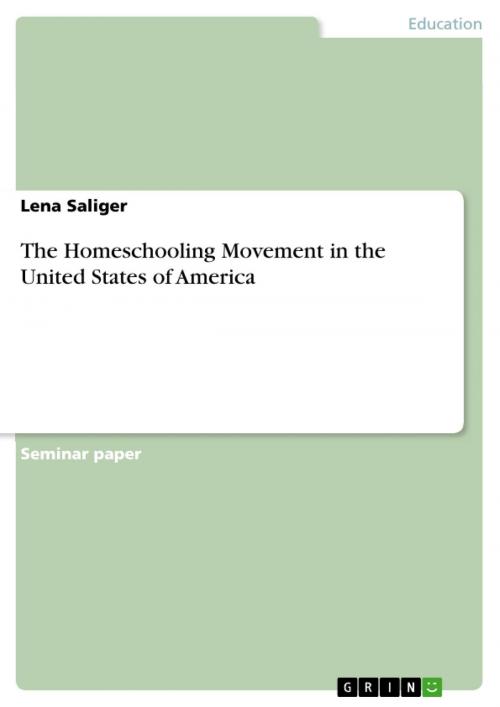The Homeschooling Movement in the United States of America
Nonfiction, Reference & Language, Study Aids, ESL, Foreign Languages| Author: | Lena Saliger | ISBN: | 9783640567522 |
| Publisher: | GRIN Publishing | Publication: | March 17, 2010 |
| Imprint: | GRIN Publishing | Language: | English |
| Author: | Lena Saliger |
| ISBN: | 9783640567522 |
| Publisher: | GRIN Publishing |
| Publication: | March 17, 2010 |
| Imprint: | GRIN Publishing |
| Language: | English |
Seminar paper from the year 2007 in the subject English - Pedagogy, Didactics, Literature Studies, grade: 1,0, University of Education Heidelberg, course: Developing Advanced Writing Skills, language: English, abstract: Like a majority of people, the Connollys had never imagined homeschooling as something they would do. But by the time, their daughter Elise entered sixth grade they noticed a personality change. Her grades began to drop - first a little then a lot. The Connollys tried to talk about it with her, but Elise was distant and noncommunicative. When the school year ended, and they received her report card, the Connollys felt disappointed and discouraged about the education of their only daughter. They immediately telephoned the school, but everyone was out for the summer. Consequently, they had to solve the problem on their own. It was difficult because Elise rejected talking about school until she finally gave way to tears. She explained having problems with some of her peers and with the character of some of her teachers. The Connollys felt that there were elements like peer pressure and violence in the school environment they had no control over. The next day, they started to investigate in homeschooling (Caruana 46). According to the sociologist Mitchell Stevens school is 'the most central institution of modern life' (15). This means that daily activities or vacations are adjusted and organized around school. Despite this, we can observe a new trend: Parents teach their children at home instead of sending them to a public or a private school. More and more children get educated at home by their parents or, in some cases, by private teachers. Homeschooling exists in many parts of the world, especially in English speaking countries, but this paper focuses on the homeschooling movement in the United States because a majority of homeschooling families can be found there. Homeschoolers are only connected by their interest in homeschooling their children and not by religion, ethnicity or class. Therefore, the typical homeschooling family does not exist. At first glance, people think that most homeschoolers are fundamentalist Christians but in fact there is a plurality of people who educate their children at home and that is why it can be hard to understand the trend.
Seminar paper from the year 2007 in the subject English - Pedagogy, Didactics, Literature Studies, grade: 1,0, University of Education Heidelberg, course: Developing Advanced Writing Skills, language: English, abstract: Like a majority of people, the Connollys had never imagined homeschooling as something they would do. But by the time, their daughter Elise entered sixth grade they noticed a personality change. Her grades began to drop - first a little then a lot. The Connollys tried to talk about it with her, but Elise was distant and noncommunicative. When the school year ended, and they received her report card, the Connollys felt disappointed and discouraged about the education of their only daughter. They immediately telephoned the school, but everyone was out for the summer. Consequently, they had to solve the problem on their own. It was difficult because Elise rejected talking about school until she finally gave way to tears. She explained having problems with some of her peers and with the character of some of her teachers. The Connollys felt that there were elements like peer pressure and violence in the school environment they had no control over. The next day, they started to investigate in homeschooling (Caruana 46). According to the sociologist Mitchell Stevens school is 'the most central institution of modern life' (15). This means that daily activities or vacations are adjusted and organized around school. Despite this, we can observe a new trend: Parents teach their children at home instead of sending them to a public or a private school. More and more children get educated at home by their parents or, in some cases, by private teachers. Homeschooling exists in many parts of the world, especially in English speaking countries, but this paper focuses on the homeschooling movement in the United States because a majority of homeschooling families can be found there. Homeschoolers are only connected by their interest in homeschooling their children and not by religion, ethnicity or class. Therefore, the typical homeschooling family does not exist. At first glance, people think that most homeschoolers are fundamentalist Christians but in fact there is a plurality of people who educate their children at home and that is why it can be hard to understand the trend.















